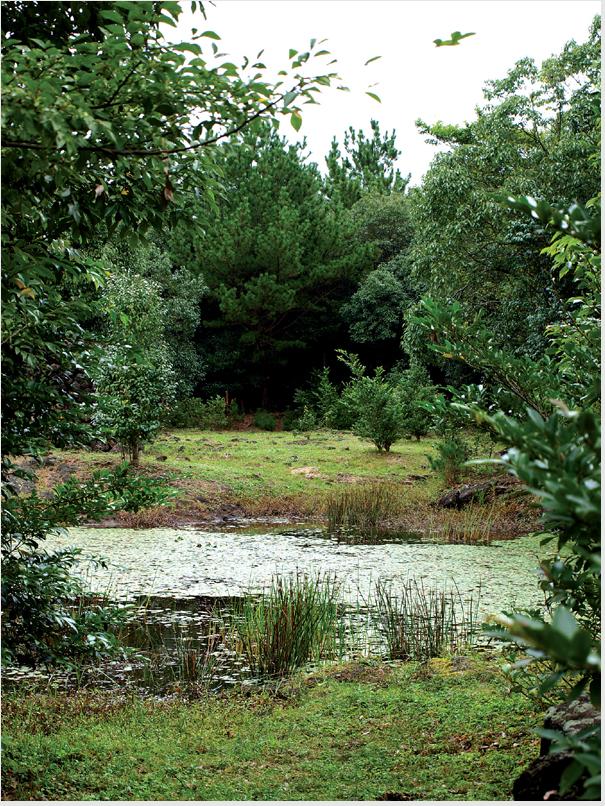| |
 |
|
| ▲ Dongbaekdongsan in Seonheul Gotjawal. Photo by Cat Lever. |
Gotjawal - old-growth forest shallowly rooted atop a volcanic rock shelf - is Jeju’s unique woodland habitat. Like the oreum and rocky coasts, it is intrinsic to not only Jeju’s ecology but also its identity and culture.
The habitat was relatively undeveloped until recently due to the rocky soils, evidence of the lava formations it sits on. Only in recent decades have the rock and woodland increasingly been cleared for golf courses and theme parks.
As per its etymology, gotjawal is woodland (got) on rocky ground (jawal). Its basaltic lava foundation is mostly “aʻā clinker” known in the Jeju language as “bille.” This lava is quintessential to gotjawal and forms a 1-3 meter deep platform, with lowland gotjawal tending to have a thicker shelf.
The fingerprints of gotjawal’s molten genesis can be seen the way it snakes seaward, spreading finger-like down the slopes of Mt. Halla. The four main areas of gotjawal are: Hangyeong-Andeok in the southwest; Aewol in the northwest; Jocheon-Hamdeok in the northeast; and Gujwa-Seongsan in the east and southeast.
Although it once covered a much larger proportion of the island, the area still under woodland is a mere 6.1 percent, or 113.3 square kilometers. The largest area of lowland gotjawal is at Seonheul, also containing the Ramsar Wetland, Dongbaekdongsan.
Seonheul Gotjawal
As the woodland is entered in Seonheul-ri, Jocheon-eup, the sickly mid-August heat is tamed by the freshness of the woods. The density of the trees and thickets block out sunlight and allow a forest breeze to pass through the branches.
Joining the path at the Dongbaek-ro entrance as it dissects the forest, the screeching cicadas reach a crescendo and dominate the atmosphere. Sound alone indicates that there is life teeming around, yet none of it is visible.
Each step we take is a small reminder of the island’s birth: rocks crunch underfoot, the protruding tip of aʻā clinker bedrock covering a vast swath of Jocheon-eup and Gujwa-eup in northeast Jeju.
Trees seem to burst forth from stones, much like old stone walls. In fact, many are old stone walls. Gotjawal was integral to the economy of Jeju villages before the widespread development now seen across the island. Part of this industry can still be seen amidst the tangled boughs, twigs and rocks.
About halfway into the wood a discrete path leads off toward a sutgamateo, a traditional kiln. Buried and swamped by roots and soil, the still-exposed relic provides a glimpse into the community’s attachment to the endangered habitat which was essential for producing charcoal, the primary local fuel into the 1970s.
The woodland certainly has an enthralling effect. Rather than an oreum which might stun visitors with its majesty, or a stretch of coast with contemplative crashing surf, gotjawal entombs the visitor on a slow ramble as each crunching step achieves an hypnotic rhythm.
Dongbaekdongsan is its crowning jewel. It is one of 18 Ramsar Wetland Sites nationally and one of four on Jeju Island. Most gotjawal areas are without groundwater, yet Dongbaekdongsan feeds from the underground reservoir, providing breeding grounds for rare bird and reptile species.
As we reach the water’s edge a warden appears, briskly warning us back. “Be careful, there are snakes here.” While in the woods they are wary of humans, she says around Dongbaekdongsan one should be alert. “This is their house, where they live.”
As we stand and admire the unique habitat, keeping at least a step or two from the bank, it is clear that the worst drought since records began has sapped the wetland. The warden stamps her foot into the dry ground.
“There is normally moisture in this earth, but now there is none. All throughout the forest you can see the dryness of the environment. We need rain.”
With that melancholy reminder of the fragility of Jeju’s few gotjawal wetlands, we continue on, now noting the crunch of each step on brittle rocks and dry twigs.
Getting there
Driving from Jeju City, take the 1132 Iljudong-ro east and then turn south at Sarabong onto the 97 Beonyeong-ro. Drive up to Bonggae-dong and turn east onto the 1136 Jungsangandong-ro at Bonggae-dong. If you are coming from Seogwipo, approach Bonggae from the south. Taking the 1136 to Seonheul-ri, follow Dongbaek-ro east about 800 meters after Seonheul-ri Gyocharo (intersection).
View Larger Map |




















